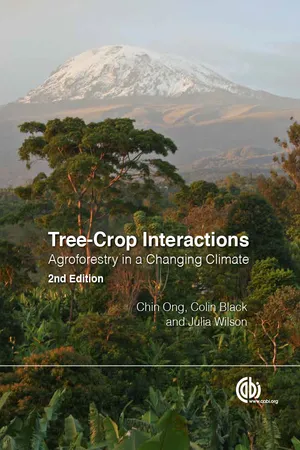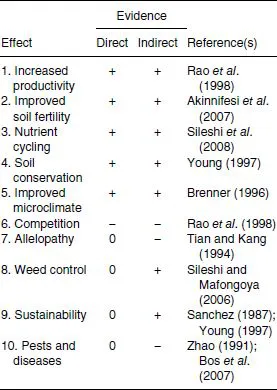
eBook - ePub
Tree-Crop Interactions
Agroforestry in a Changing Climate
This is a test
- English
- ePUB (mobile friendly)
- Available on iOS & Android
eBook - ePub
Book details
Book preview
Table of contents
Citations
About This Book
This new edition provides an update on the considerable amount of evidence on tree-crop interactions which has accumulated during the last two decades, especially on the more complex multi-strata agroforestry systems, which are typical of the humid tropics. In addition three new chapters have been added to describe the new advances in the relationship between climate change adaptation, rural development and how trees and agroforestry will contribute to a likely reduction in vulnerability to climate change in developing countries
Frequently asked questions
At the moment all of our mobile-responsive ePub books are available to download via the app. Most of our PDFs are also available to download and we're working on making the final remaining ones downloadable now. Learn more here.
Both plans give you full access to the library and all of Perlego’s features. The only differences are the price and subscription period: With the annual plan you’ll save around 30% compared to 12 months on the monthly plan.
We are an online textbook subscription service, where you can get access to an entire online library for less than the price of a single book per month. With over 1 million books across 1000+ topics, we’ve got you covered! Learn more here.
Look out for the read-aloud symbol on your next book to see if you can listen to it. The read-aloud tool reads text aloud for you, highlighting the text as it is being read. You can pause it, speed it up and slow it down. Learn more here.
Yes, you can access Tree-Crop Interactions by Chin K Ong, Colin Black, Julia Wilson in PDF and/or ePUB format, as well as other popular books in Scienze biologiche & Biologia. We have over one million books available in our catalogue for you to explore.
Information
Topic
Scienze biologicheSubtopic
Biologia 1 A Framework for Quantifying the Various Effects of Tree–Crop Interactions
1University of Nottingham, Malaysia Campus, Selangor, Malaysia;
2Einsteinstraat 11, Nijmegen, The Netherlands

*E-mail: [email protected]
Introduction
Agroforestry systems will be able to mimic or replicate many of the nutrient-cycling and favourable environmental influences found with forest ecosystems, while generating the exportable outputs achieved with agricultural systems.
(Kidd and Pimentel, 1992)
Early assessments of the potential benefits of agroforestry at the farm level were based largely on the assumption that it is possible to extrapolate from existing information on forestry and agriculture (Huxley, 1983; Nair, 1993), and partly on observations of traditional agroforestry systems that showed increased growth of understorey vegetation (Ong and Leakey 1999; Kho et al., 2001). Various negative effects have also been recognized, such as competition for moisture, excessive shading and allelopathy, although these have attracted much less attention from scientists. Most of the evidence of benefits and drawbacks of agroforestry continues to be qualitative or indirect, i.e. extrapolated from a wide range of systems, creating often unrealistic expectations of the benefits of agroforestry technologies (Garcia-Barrios and Ong, 2004). Fortunately, the volume of agroforestry research has grown rapidly since 1983, as various international and national institutes have become involved in both tropical and temperate regions (Sanchez, 1995; Rao et al., 1998). With many field experiments in progress, the growing volume of evidence necessary to establish a scientific basis for the quantitative analysis of the various interactions that occur when trees and crops are grown together in a range of climatic and geographical regions is rapidly becoming available.
The past decade has experienced weather patterns and global temperatures outside the normal range, and the likelihood of climate change is now broadly accepted (Boko et al., 2007). Large percentages of human populations in developing countries derive their livelihoods from agriculture and are particularly vulnerable to climate change. For example, the Intergovernmental Panel on Climate Change has presented evidence that climate is modifying the natural ecosystems and Chagga homegardens on Mount Kilimanjaro through complex interactions and feedbacks (Hemp, 2006; Boko et al., 2007; see cover photograph). The traditional Chagga homegardens maintain a high biodiversity with over 500 vascular plant species and over 400 non-cultivated plants, and are typical of the multi-layered agroforestry systems throughout the humid tropics of South-east Asia, Africa and Latin America (Fig. 1.1). During the past few decades, many of these homegardens have been abandoned by smallholders, who have focused instead on growing new coffee varieties that are sun tolerant and do not require the shade provided by the traditional system. However, recent studies in Uganda show that intercropping banana and coffee is highly profitable for smallholders and can even enable them to cope with the effects of climate change (van Asten et al., 2011). To feed everyone adequately, the world food supply will need to double over the next 30 years (Cleaver and Schreiber, 1994). In many countries, there will be limited ability for new varieties and increased fertilizer use to increase yields (Huang et al., 2002). Climate change will add additional stress to an already overtaxed system. For example, it is predicted that climate change will reduce the length of the growing season of rice (Aggrawal and Mall, 2002) and affect the incidence of pests and diseases, whose incidence is often still poorly understood. Agroforestry options may provide a means of diversifying production systems and increasing the resilience of smallholder farming systems to climate extremes (Lin, 2011; de Leeuw et al., 2014). However, research into the contribution that agroforestry may be able to make in buffering against climate change and variability is not well advanced (Verchot et al., 2007). Work on alternatives to slash-and-burn agriculture in the humid tropics has provided solid evidence of the potential of agroforestry systems in Sumatra and Cameroon (Gockowski et al., 2001; Palm et al., 2004). These systems can be promoted through the Clean Development Mechanism (CDM) to create synergies between mitigation and adaptation and to meet the requirements that CDM projects produce social as well as environmental benefits at the global level. Four new chapters in this second edition of this book explore how agroforestry systems may buffer against climate change by modifying microclimatic conditions (Chapter 5), mitigation of the impact of temperature extremes on important crops such as coffee and rice (Chapter 10), the beneficial effects of scattered trees in parklands (Chapter 11) and finally a synthesis of the prospects for crops for the future (Chapter 12).

Fig. 1.1. Profile and ground plan of a typical Chagga homegarden at Old Moshi, Kilimanjaro, Tanzania. (Figure courtesy of Andreas Hemp, Institute of Plant Physiology, University of Bayreuth, Germany.)
A scientific framework for quantitative analysis of tree–crop interactions is needed for several reasons. First, it should provide reliable methodology to determine which benefits are likely to be realized for a given agroforestry technology in a defined situation. Secondly, it should enable researchers to evaluate the relative importance of each interaction in order to guide them more precisely in the choice of research priorities. This is no trivial matter, as agroforestry research requires long-term commitment of research resources, and it is not easy to separate the complex interacting factors involved (Anderson and Sinclair; 1993; Rao et al., 1998; Garcia-Barrios and Ong, 2004). Thirdly, the advantages of agroforestry cannot be quantified simply in terms of productivity alone, because some of the benefits result from environmental improvements such as erosion control and increased soil organic matter content; these cannot be measured within only a few seasons. Finally, a quantitative approach is an important step in the quest for a fuller understanding of the complex mechanisms of tree–crop interactions, which should offer the scientific basis for designing yet more productive and sustainable agroforestry systems.
This chapter briefly describes the individual effects of tree–crop interactions and suggests how these may be quantified. Subsequent chapters examine how tree–crop interactions can be explained in terms of competition principles (Chapter 2) and a simple model of shading and water balance (Chapter 3). Later chapters explore the physiological and physical mechanisms involved in each interaction in detail.
Main Types of Tree–Crop Interactions
Before considering methods for quantifying the overall effects of tree–crop interactions, it is useful to list the biophysical benefits and consequences that are commonly attributed to agroforestry systems to determine whether the evidence for each interaction is based on direct or indirect observations. The relative importance of each effect will depend on both the type of agroforestry system and the location of the site. For example, the effects of any soil fertility enrichment by agroforestry will be less obvious if fertilizer input is high. For the purpose of this chapter, it is premature to include effects that have not yet been substantiated by field observations. For example, there is no quantitative experimental evidence concerning the effectiveness of agroforestry in controlling weeds or maintaining sustainability (Table 1.1), although there are good theoretical reasons to expect such benefits. Another unresolved issue is the potential importance of allelopathy, which has been reported repeatedly for some tree species under laboratory conditions but is doubtful in field conditions for various reasons (see the critical review by Horsley, 1991).
Table 1.1. Main effects of tree–crop interactions. + and − denote positive and negative effects; 0 indicates that no evidence is available. Key sources are cited.

There is ample evidence that overall biomass production in agroforestry systems is generally greater than in annual cropping systems, although not necessarily greater than in forestry or grassland systems. The basis for the potentially higher productivity may be due to increased capture of growth resources such as light, water and nutrients (Chapter 4, this volume), or improved soil fertility. Competition, a negative influence in this context, is often a significant factor in simultaneous agroforestry systems, even when there is evidence that the combined productivity by both components is increased. It is fair to conclude that only the top six effects shown in Table 1.1 have been substantiated by field observations. Certainly, there remains an urgent need for research to acquire more ‘hard evidence’ before the formidable task of translating the ‘promise’ of agroforestry into sustainable land use can be attempted.
Soil fertility improvements
Many of the frequently quoted examples of improvements in soil fertility are based on traditional agroforestry systems that have been established for many years. The potential for microsite enrichment by some trees is an extremely important aspect of agroforestry that has received considerable attention (Nair, 1984; Young, 1997). Surprisingly...
Table of contents
- Cover
- Half Title
- Title
- Copyright
- Contents
- Contributors
- Preface
- Acknowledgements
- Tribute to Professor Colin Black
- 1 A Framework for Quantifying the Various Effects of Tree–Crop Interactions
- 2 Mixed Cropping of Annual and Woody Perennial Species: An Analytical Approach to Productivity and Management
- 3 Modelling Radiation Interception and Water Balance in Agroforestry Systems
- 4 Principles of Resource Capture and Use of Light and Water
- 5 Agroforestry and (Micro) Climate Change
- 6 The Water Balance of Mixed Tree–Crop Systems
- 7 Competition and Phenology in Agroforestry
- 8 Root Distribution of Trees and Crops: Competition and/or Complementarity
- 9 Laboratory and Field Techniques for Measuring Root Distribution and Architecture
- 10 Adaptation for Climate-sensitive Crops Using Agroforestry: Case Studies for Coffee and Rice
- 11 Adaptation of Crops to Partial Shade in Mixed Cropping Systems
- 12 Synthesis: Key Agroforestry Challenges in the Future
- Index
- Back Cover